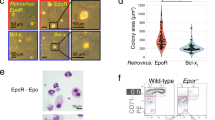Abstract
Haematopoiesis is a useful model system for studying differentiation and the regulation of precursor cell populations intermediate between the multipotential stem cell and terminally differentiated end cells. For many years, erythropoietin (Epo) was recognized as the hormone which controls red cell production in vivo1. Although other substances are now known to be required during the initial stages of erythropoiesis2,3, late erythroid differentiation is regarded as strictly Epo-dependent4. This concept is supported by the recent demonstration that the addition of Epo alone to serum-free bone marrow cell cultures is sufficient to stimulate the CFU-E (colony-forming unit-erythroid—a late erythroid precursor cell approximating to a proerythroblast) to complete differentiation into mature erythrocytes.5 However, the data reported here indicate that mature erythroid colonies (indistinguishable from those formed by CFU-E + Epo) are formed when adult bone marrow cells are grown for 2 d in methyl cellulose cultures containing spleen cell-conditioned medium (SCM) but no added Epo. SCM is a rich source of growth factors6,7 and initial observations8 suggested that its ‘Epo-like’ activity could be attributed to: (1) Epo, or (2) a factor which enhances the activity of small amounts of Epo in the culture medium, or (3) a factor(s) distinct from Epo which is also capable of stimulating late erythroid differentiation. The experiments reported here, which include a partial characterization of the ‘Epo-like’ activity, support the latter interpretation.
Similar content being viewed by others
References
Krantz, S. B. & Jacobson, L. O. in Erythropoietin and the Regulation of Erythropoiesis, 13–24 (University of Chicago Press, 1970).
Iscove, N. N. & Guilbert, L. J. in In Vitro Aspects of Erythropoiesis. (ed. Murphy M. J.) 3–7 (Springer, New York, 1978).
Wagemaker, G. in In Vitro Aspects of Erythropoiesis. (ed. Murphy M. J.) 44–57 (Springer, New York, 1978).
Metcalf, D. Recent Results Can. Res. 61, 161 (1977).
Iscove, N. N., Guilbert, L. J. & Weyman, C. Expl Cell Res. 126, 121–126 (1980).
Parker, J. W. & Metcalf, D. Immunology 26, 1039–1049 (1974); J. Immun. 112, 502–510 (1974).
Metcalf, D., MacDonald, H. R., Odartchenko, N. & Sordat, B. Proc. natn. Acad. Sci. U.S.A. 72, 1744–1748 (1975).
Fagg, B. & Odartchenko, N. Expl Hemat. 7, Suppl. 6, 123 (1979).
Ryser, J.-E., Cerottini, J-C. & Brunner, K. T. J. Immun. 120, 370–377 (1978).
Johnson, G. R. & Metcalf, D. Proc. natn. Acad. Sci. U.S.A. 74, 3879–3882 (1977).
Metcalf, D. & Johnson, G. R. J. cell. Physiol. 96, 31–42 (1978).
Iscove, N. N., Sieber, F. & Winterhalter, K. H. J. cell. Physiol. 83, 309–320 (1974).
Burgess, A. W., Metcalf, D., Russell, S. H. M. & Nicola, N. A. Biochem. J. 185, 301–314 (1980).
Author information
Authors and Affiliations
Rights and permissions
About this article
Cite this article
Fagg, B. Is erythropoietin the only factor which regulates late erythroid differentiation?. Nature 289, 184–186 (1981). https://doi.org/10.1038/289184a0
Received:
Accepted:
Issue Date:
DOI: https://doi.org/10.1038/289184a0
- Springer Nature Limited
This article is cited by
-
Compensatory neoplasia: Chronic erythrocytosis and neuroblastic tumors
Theoretical Medicine (1984)
-
Differentiation of erythroid precursors in organ cultures of mouse embryonic liver
Bulletin of Experimental Biology and Medicine (1983)




